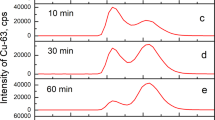Abstract
After administering an oral dose of monofluorophosphate (MFP) to human beings or rats, a fraction of the drug appears in plasma that is bound to proteins, establishing a previously undetected compartment of nondiffusible fluoride. This article documents experiments performed in vitro, describing the binding of MFP to two plasma globulins: α2-macroglobulin and C3 (a β-globulin). MFP binds irreversibly to these proteins through a stable bond. MFP binds to purified α2-macroglobulin or to C3 with a molar ratio MFP: protein close to unity. MFP binding reduces significantly the biological activity of these proteins, which share in common a macrocyclic 4-residue ring thiolactone (Cys—Gly—Glu—Glu).
The binding site of MFP is as yet unknown. Protein-bound MFP appeared in the plasma of volunteers during the 5–7 hours following intake. Peak concentration of protein-bound MFP and maximal reduction of α2-macroglobulin activity was observed 2 hours after intake. Clearance of protein-bound MFP coincided with the return of α2-macro-globulin to basal levels.
Similar content being viewed by others
References
Rigalli A, Morosano M, Puche RC (1996) Bioavailability of fluoride administered as sodium fluoride or sodium monofluorophosphate to human volunteers. Arzneim Forsch/Drug Res 46:531–533
Rigalli A, Cabrerizo MA, Beinlich AD, Puche RC (1994) Gastric and intestinal absorption of monofluorophosphate and fluoride in the rat. Arzneim Forsch/Drug Res 44:651–655
Rigalli A, Ballina JC, Beinlich AD, Alloatti R, Puche RC (1994) Pharmacokinetic differences between sodium fluoride and sodium monofluorophosphate and comparative bone mass increasing activity of both compounds in the rat. Arzneim Forsch/Drug Res 44:762–766
Tack BF, Prahl JW (1976) Third component of human complement: purification from plasma and physiochemical characterization. Biochemistry 15:4513–4521
Swenson RP, Howard JB (1979) Structural characterization of α2-macroglobulin subunits. J Biol Chem 254:4452–4456
Taves D (1968) Separation of fluoride by rapid diffusion using hexamethyldisiloxane. Talanta 15:969–974
Kabat EA, Mayer NM (1961) Experimental immunochemistry, 2nd ed, Ch. Thomas, Springfield, Illinois, p. 149
Tallarina R, Murray R (1986) Manual of pharmacologic calculations with computer programs. Springer-Verlag, New York
Khan SA, Erickson BW (1981) Synthesis of macrocyclic peptide thiolactones as models of the metastable binding sites of α2-macroglobulin and complement protein C3b. J Am Chem Soc 103:7374–7376
Geigy Scientific Tables (1984) vol III, Ciba-Geigy, Basle, Switzerland
van Dijk MC, Boers W, Linthorst G, van Berkel TJ (1992) Role of the scavenger receptor in the uptake of methylamineactivated α-2-macroglobulin by rat liver. Biochem J 287:447–455
Ohlsson K, Laurell CB (1976) The disappearance of enzymeinhibitor complexes from the circulation of man. Clin Sci Mol Med 51:87–92
Author information
Authors and Affiliations
Rights and permissions
About this article
Cite this article
Rigalli, A., Esteban, L., Pera, L. et al. Binding of monofluorophosphate to α2-macroglobulin and C3. Calcif Tissue Int 60, 86–89 (1997). https://doi.org/10.1007/s002239900190
Received:
Accepted:
Issue Date:
DOI: https://doi.org/10.1007/s002239900190



